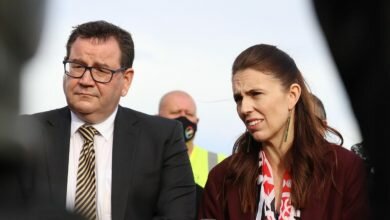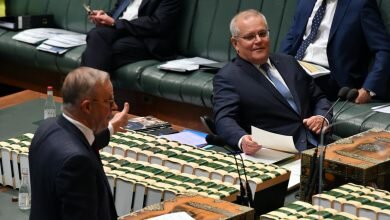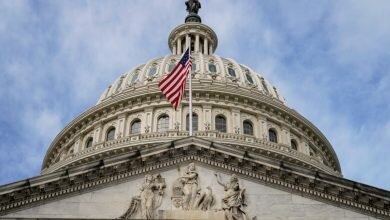The ‘perfect storm’: is the Australian economy heading towards the 1970s?

The economic turmoil of the ’70s marked the beginning of the neoliberal era of small government, as Britain and the US turned to Margaret Thatcher and Ronald Reagan, respectively, to repair their national economies. Neoliberalism came to Australia sometime later, and in a moderate form, with the election of the Hawke government in 1983.
The economic and energy challenges facing Australians this winter are still not as devastating as they were in the 1970s. It is too early to know whether they will change society in the long run.
The economic and energy crisis of the 1970s paved the way for Margaret Thatcher’s Conservative Party to seize power in the United Kingdom. credit: AP
However, after the past week, the enormity of those challenges is undeniable. The era of COVID-19 lockdowns and border closures may be over, but the nation faces another winter of discontent as consumer prices rise, interest rates rise and energy markets struggle to meet demand. Is.
In the words of Treasurer Jim Chalmers, the country is facing a “perfect storm” of simultaneous spikes in gas prices, electricity prices and petrol prices.
In a scathing statement two weeks ago, Australian Industry Group chief executive Ines Willocks warned: “The apocalyptic surge in energy prices threatens chaos for industry and pain for families.”
Explaining the factors behind the crisis, Willox said: “The immediate pressures are from outages at older coal plants, resulting in higher gas demand for electricity and the collapse of a medium-sized gas retailer. But beyond these intense pressures stretch international coal and gas prices, which are unprecedentedly high in the wake of Ukraine’s invasion. ,
And the result? “Houses will feel the punch from higher default electricity prices from July, and more pain is coming for all.”
Willocks’ statement was as predictable as it was dangerous. On Wednesday, the Australian energy market operator made an unprecedented market intervention by suspending trading across the entire East Coast electric power network.
Speaking at an emergency press conference that night, NSW Treasurer and Energy Minister Matt Keane urged residents of his state to reduce non-critical electricity use in the busy hours of the evening.
“This is the result of many of our coal-fired power stations not working when we need them to,” he said.
“The number of generators working tonight has not come. It shows why we need a plan to modernize our electricity system, but in the meantime, we need to make sure our coal-fired power stations are working when we need them.
In Victoria, the Andrews government insisted the state had an adequate energy supply, but warned Victorians that they would face potential gas shortages next winter.
NSW Treasurer Matt Keane issued a rare call for residents of his state to limit nighttime electricity use. credit: Oscar Coleman
The crisis is leading experts to take a long look at the role of government and the private sector in determining how the energy market works. Saul Eslake, former chief economist at ANZ Bank, says that although this runs against his “core assumptions”, Australia’s eastern states may need to emulate Western Australia’s policy of domestic gas reservations.
He was usually opposed to such heavy-handed interventions, but extraordinary times require remarkable measures.
It’s loading
“It’s hard to justify why Australia is paying record prices and experiencing rationing so that companies that don’t pay much taxes can sell gas overseas at extraordinarily high prices,” says Eslake. “It suggests that the rules of the game need to change.”
This week there was a stir in the stock market with the power market turmoil. Nearly $90 billion was wiped off the value of the Australian stock market on Tuesday, the worst one-day drop since the start of the pandemic two years ago.
The sell-off reflected global fears of a return to the ’70s-style period of ‘Great Inflation’. As gas and electricity prices rise, so are the costs of basic food items – from $12 iceberg lettuce to $9 for a cauldron at Sydney Markets.
Brian Sammut, a third-generation farmer from Sydney, said, “We have seen some prices are very high, but not so high.” To inform This week.
“The problem is across the board. Everything is expensive.”
Sarah Hunter, a senior economist at KPMG, says: “In the 1970s the world was experiencing shocks that are indistinguishable from what we see today … I think what is happening is described as a stagflation It’s worth doing.”
In the United States, former Treasury Secretary Larry Summers is making a similar argument, urging policymakers not to downplay the potential economic chaos that can unfold if the settings are not right.
“The current inflation regime is closer to the late 1970s than it may have first appeared,” conclude Summers and co-authors of the International Monetary Fund in a new research paper published this week.
If you take today’s methods for calculating inflation and apply them to older data, Summers found that inflation in the United States in the 1970s and early ’80s actually peaked at 11.4 percent. This is 3 percentage points higher than its current rate in the US.
Describing the current US inflation situation as the worst the country has faced since 1979, Summers predicts doom on the horizon. “The Fed’s current policy trajectory is likely to propel inflation, with both unemployment and inflation averaging over 5 percent over the next few years — and eventually leading to a major recession,” he wrote recently. was written in Washington Post,
Philip Lowe made a rare appearance this week at 7:30. credit: getty
Anyone suspecting that we live in dramatic times only needs to tune into ABC on Tuesday nights. Leigh Sales, who is soon to leave the presenter’s chair, did not indulge in exaggeration when she told the audience that she had gotten a rare interview with the Governor of the Reserve Bank of Australia, Philip Lowe.
It was the first time since 2010 that Lowe’s predecessor Glenn Stevens sat down with sunrise Host David Koch – That an RBA governor sat down for a TV interview. The sit-down comes a week after the RBA raised the official cash rate to 0.85 per cent, the highest level since September 2019.
Lowe’s previously issued guidance that he did not expect rates to rise until 2024, an error he has since admitted was “shameful”.
It’s loading
Eslake says Lowe’s extremely unusual appearance, but 7.30showed they knew they needed to explain to Australians why the RBA was so quick to raise rates.
“Even the financial markets are surprised at how quickly the RBA has changed,” Eslake says. “His remarks were addressed to those who took the Reserve Bank at face value when it said it would remain at a record low until 2024.”
In an interview with Sales, Lowe warned that he expects inflation to reach 7 percent by the end of the year, significantly higher than the 6 percent forecast by the RBA a few weeks ago.
“It’s a huge number, and we need to be able to chart the course of 2 percent to 3 percent inflation. I believe we can do that, but it’s going to take time.”
Lowe said the cash rate may need to be raised to 2.5 percent, though he would not say how long it would take to get there.
“In each of our meetings, we will decide how fast we need to go and, exactly, how far we need to go,” he said.
While he sees a clear connection to the 1970s, historian Paul Strongio cautions against taking the comparisons too far – especially in the Australian context. “The economic pressure now looks a lot more modest,” he says. He points out that no one is predicting that household inflation will rise nearly as high as it was under Whitlam.
He says that stagflation is, troublingly, something that policy makers have a better grasp on than they were five decades ago, when it was an entirely new concept.
“In the Whitlam era, Labor lacked the intellectual resources to manage the crisis. There was intense internal conflict within the government about what to do when faced with an unprecedented situation. I do not think the new Albanese Labor government It will happen here with U.S. He has more intellectual knowledge, he has discipline, he has experience of government.”
It’s loading
Eslake agrees, adding that no one expects inflation to remain dangerously high at one point in time, as it did in the Whitlam and Fraser eras. “Unemployment is very low, and while it can rise, no one is expecting it to go to a rate as high as the historically high rates in the 1970s,” he says.
He adds another important advantage: Australia now has an independent Reserve Bank with a fixed inflation target of 2 to 3 percent.
To say that things were worse in the past is certainly not to say that they are easier today. Winter has just begun, and Australia’s economic and energy dilemmas are not going to go away anytime soon.




